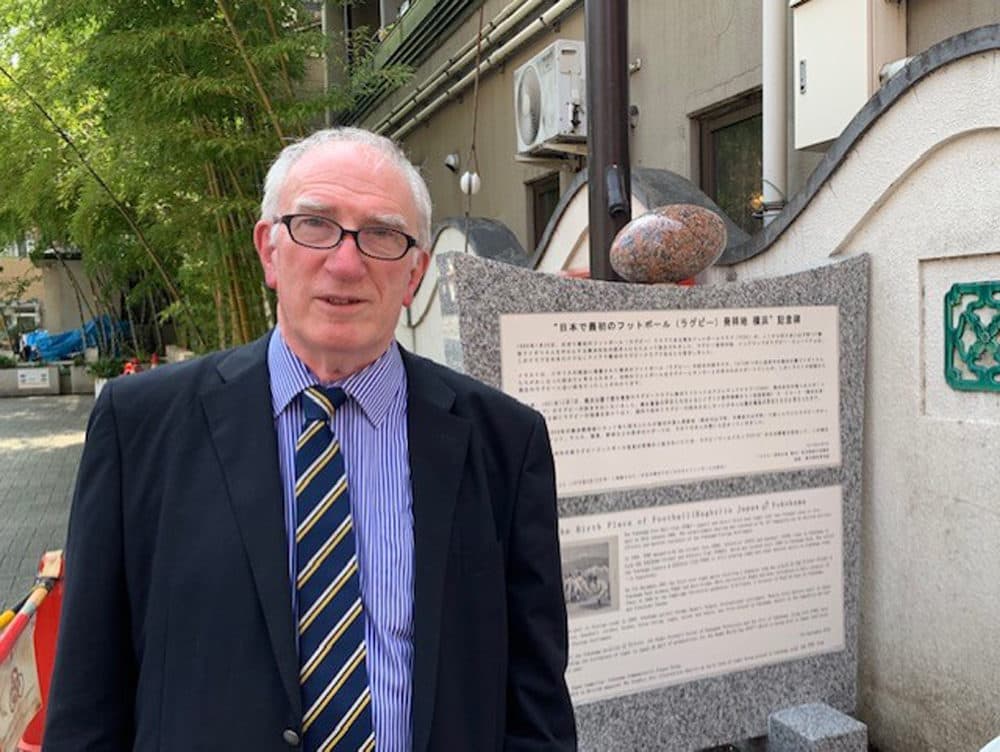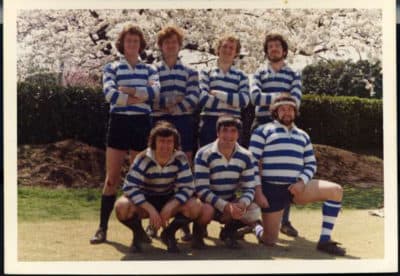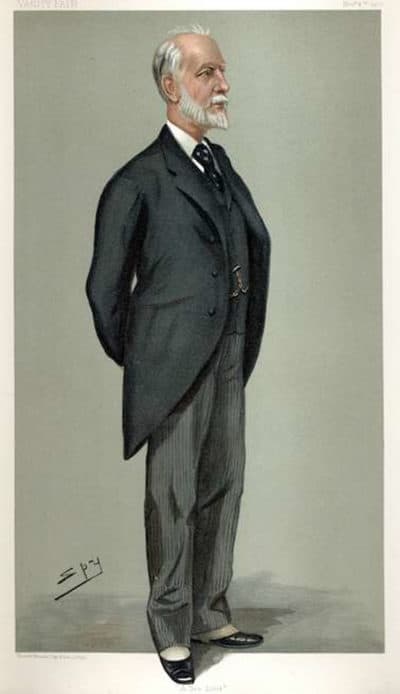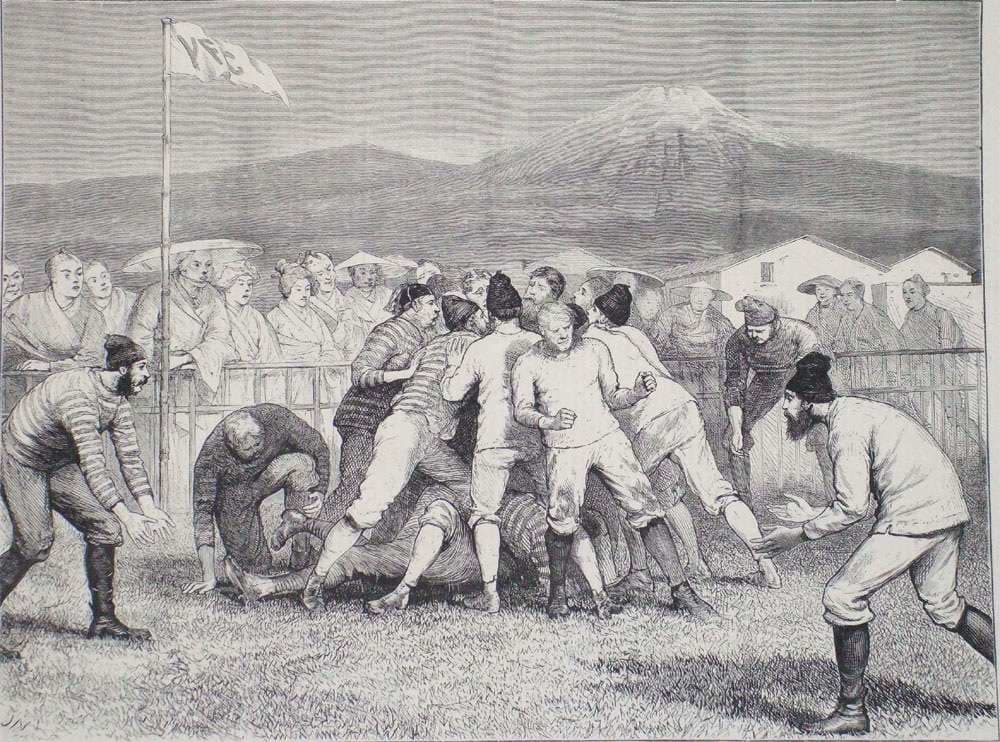Advertisement
Samurai, Warships And An Armed Cricket Match: The Real Story Of Rugby In Japan
Resume
Japan has gone rugby-mad as the country hosts the World Cup. It's the first time that an Asian country has hosted the Rugby World Cup.
The opening ceremonies featured kabuki dancers and a children’s choir surrounding a huge model of Mount Fuji.
Dates and images were projected onto the sides of Mount Fuji — starting with 1823, when a British student named William Webb Ellis, playing the game we would call soccer, picked up the ball and ran with it, “inventing” the sport of rugby.
The images fast-forward to 1899 when a schoolteacher at Keio University was credited with first introducing the sport in Japan.
But that’s not how it actually happened. The real story involves samurai, British warships and an armed cricket match.
The Rugby Historian From Rugby, England
Mike Galbraith is a rugby historian who lives in the town of Rugby. Really. It’s an actual town in England, home of the Rugby School, where the sport was first invented sometime in the 1820s.
"That part is not in dispute," Galbraith says. "But whether William Webb Ellis — the World Cup is named after William Webb Ellis — whether he actually invented rugby is disputed. Heavily disputed."
Galbraith grew up in England, but he’s spent much of his life in Japan. That’s where he is right now, for the World Cup.
Galbraith first arrived in Japan in 1973, when he was on what he calls a “world tour.” And he stayed, in large part, because of rugby.
"Well, when I first came to Japan, I wasn't aware that people played rugby," Galbraith recalls. "But I shared an apartment with an American guy. He was working as a movie extra."
Galbraith says the movie’s title, translated into English, was “Japan Sinks,” or something like that. Days on set were long, so Galbraith’s housemate started talking to the actor sitting next to him, a rugby player from Australia.
"He said, 'Oh, my friend, he likes rugby,' " Galbraith says. "As a result of this, I went down to the Yokohama Country & Athletic club. I said, 'I'd like to try out.' And they said, 'OK, play in our second team.' And then they said, 'That's good. Next week, you're in the first team.' That's how I started."

Fourteen years later, Galbraith was still in Japan, still playing rugby.
"1987, "Galbraith says. "I was the captain of the Yokohama team."
The Yokohama team wanted to attend the first Rugby World Cup, being held that year in Australia and New Zealand. To raise money, they sold advertising in a tour program. And to fill some space, Galbraith set out to write a history of rugby in Japan.
The story that everyone believed was, by that point, well established.
"In Japan, there seems to be a desire to have a nice, happy story where this Western sport is introduced by a single Westerner, and the Japanese take it up and become good at it," Galbraith says. "So in the case of rugby, his name was Edward Bramwell Clarke."
The Official History
Edward Bramwell Clarke was born in Japan, but he was educated at Cambridge. As the story goes, when Clarke returned to Japan and began teaching English at Keio University in Tokyo, he wanted to give his students a more constructive way to spend their free time. So he taught them the game of rugby. The year was 1899.
"That's the official story from the Japan Rugby Union," Galbraith says.
But when Galbraith started looking through the archives at the Yokohama Country & Athletic Club, he didn’t have to search very hard to find an account that seemed in conflict with that official story.
"It started with 'It was said that British "Tommies" played the sport in the 1860s,' " Galbraith says.
This account of British soldiers playing the sport in the 1860s — it hadn’t been lost, exactly. But historians had always treated it as a one-off, something that didn’t connect to the story of how the game caught on in Japan.

Galbraith wrote up what he’d found for that tour program. And that was it until 2009. This time, Galbraith was arranging a tour of Japan for a British rugby team called Oxbridge. Again, he needed to raise money, so again, he decided to make a program and include a history of rugby in Japan.
"Oxbridge is quite prestigious, so I decided to make more effort this time," Galbraith says.
Galbraith went back to the archives. And this time he found definitive proof that rugby had a foothold in Japan more than three decades before Edward Bramwell Clarke taught the game to his students at Keio University.
"People might think that I looked through millions of pages of newspapers, and I came across this article," Galbraith says. "That's not really true."
In fact, almost right away, Galbraith found a book that pointed him to an article that documented the creation of the Yokohama Foot Ball Club in 1866.
"And when I read it, I thought, 'Wow, this is amazing,' " Galbraith recalls. "I thought, 'This is very, very early.' "
1866. That’s older than any other rugby team in all of Asia.
"But then, when I took the information to the Japan Rugby Union, they said, 'Thank you very much.' But they would never recognize it," Galbraith says.
A Samurai And An Armed Cricket Match
No matter, Galbraith kept searching. And that search brought him to the year 1859.
"Until 1859, foreigners were not allowed to come into Japan or reside in Japan at all," Galbraith says. "Commodore Perry came with what's called the 'Black Ships,' steam ships with powerful guns. So the Japanese were forced to open up."
Three years later, in 1862, an English merchant named Charles Lennox Richardson decided to spend some time in Yokohama on his way home from Shanghai.
"One day, he went riding with some of his friends in Yokohama," Galbraith says. "Unfortunately for him, a few hours earlier, a daimyō, which is a kind of lord, and his retinue had set off from Tokyo to go to Kyoto. And they came into contact. They collided. Maybe three or four miles from Yokohama."
"There is an account that says the wicket-keeper was carrying a pistol."
Mike Galbraith
Nobody’s exactly sure what happened next. Some accounts say Richardson didn’t show the proper respect to the daimyō. Others suggest Richardson’s horse spooked. But what we do know is that Richardson was killed by the daimyō’s samurai.
Tensions escalated. The Japanese emperor issued an edict requiring all foreigners to leave the country by May 11, 1863. But the merchants refused to go. British warships came into the harbor to protect them.
"There were Marines on the warships," Galbraith says. "But, you know, it would take quite a while for them to get ashore and protect you if there was an attack, you see."
So, the day after the deadline was set to expire, the merchants invited the Navy ashore for a cricket match.
"And so one team is called the Shore Team, so that was the merchants. And then one was called the Navy," Galbraith says. "The ground they played on was ringed by Marines. But there is an account that says the wicket-keeper was carrying a pistol, and he would put the pistol behind the stumps and take six balls, an over. And then he'd pick up the pistol, walk to the other end, put it down behind there."
And this is where we get back to rugby. Because in the accounts of that armed cricket match, Galbraith found one description that said...
"Half the players were playing football," Galbraith says.
"And of course, in this case, football means rugby, right?" I ask.
"Um, not really," Galbraith answers. "I think it was an early form of rugby rules football."

Keep in mind, this was 1863. Rugby wouldn’t officially become a sport until eight years later, in 1871. But Galbraith has done his research, and he’s confident that the style of football played on that day would have been the style played at the Rugby School.
Galbraith eventually linked the Yokohama Foot Ball Club, founded in 1866, to the Yokohama Country & Athletic Club that he joined in 1973 — meaning that those early games played by British "Tommies” weren’t one-offs. They were part of a continuous tradition of the sport in Japan.
Recognition After 10 Years
In 2015, with all of his new evidence in hand, Galbraith again approached the Japan Rugby Union to try to persuade them to change their official history.
"And I sent my evidence, copies of the key articles that I found, and I sent it to them," Galbraith says. "And I didn't get any response."
With help from a friend, Galbraith was finally able to get a response, though it wasn’t the one he was hoping for.
" 'We are not interested in rebutting your evidence, and we're not interested in accepting your evidence. We're just not interested in what you've given us,' " Galbraith recalls.
But as the 2019 World Cup was approaching, officials in Yokohama decided to embrace their connection to rugby’s early history. That’s why, late last month, the head of Japan’s Rugby Union unveiled a commemorative plaque in a public park near the site where the Yokohama Foot Ball Club was first established in 1866.
Mike Galbraith was there.
"I wasn't there for the plaque unveiling, but I arrived half an hour later," Galbraith says. "And, at the press conference, I was asked what my thoughts were. I said to them, 'There is a saying in Japanese, which translated into English means, "Sit on a rock for three years. Be patient." So I said to them, 'I'm very happy to be able to get off this rock after 10 years.' And they all laughed."
Mike Galbraith's research can be found on his website.
This segment aired on November 2, 2019.
